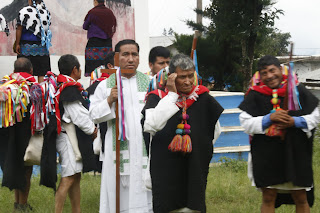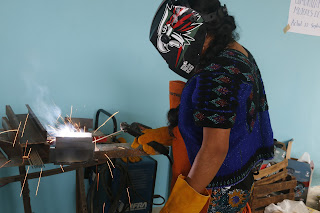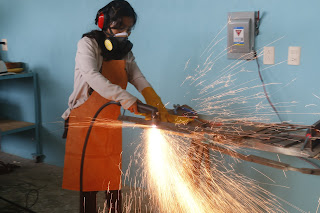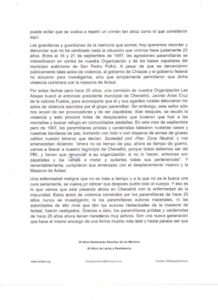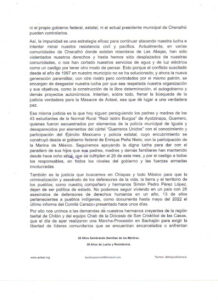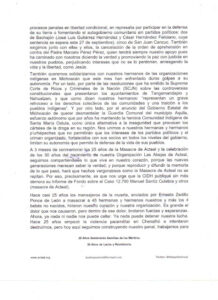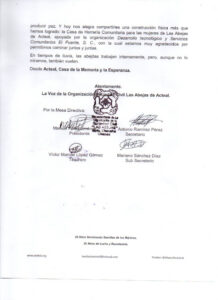
Chiapas
(Español) Organizaciones denuncian persecución hacia familias migrantes tsotsiles en Puebla
Fuente: Avispa Midia
Por Ñaní Pinto
Foto de archivo del pueblo tsotsil desplazado por grupos paramilitares
El pasado 10 de febrero de 2022, personal del DIF Estatal de Puebla en coordinación con elementos de la policía municipal despojaron a dos niñas indígenas de sus familias mediante engaños, el uso excesivo de la fuerza y amenazas. Son familias en situación de desplazamiento interno (migración interna) provenientes de comunidades tsotsiles de los Altos de Chiapas, que han migrado a la ciudad de Puebla en la búsqueda de mejorar sus condiciones de vida debido a la extrema pobreza que viven en sus comunidades.
Roque H. y María R., padres de Estefanía H. de 3 años, y Fernando M., tío de Vanesa H. de 9 años, relatan que el día de la separación se encontraban trabajando en el crucero del Boulevard Atlixco con Camino Real a Cholula, cuando personal del Sistema para el desarrollo Integral de la Familia (DIF) de Puebla se les acercó con la supuesta intención de brindarles apoyo humanitario mediante despensas y atención médica para las niñas.
Invitación que la madre, el padre y el tío rechazaron inmediatamente, dada la desconfianza que les generó al no ver las despensas y al percibir su insistencia por trasladarlos a otro lugar. Tras la negativa de las familias a movilizarse, elementos de la policía municipal llegaron al lugar para obligarlos mediante intimidaciones y amenazas a subirse a la camioneta del DIF y ser trasladados a sus instalaciones.
Marisa R. refiere que el personal del DIF le arrebató de sus brazos a su hija mediante el uso excesivo de la fuerza, obligándola a subirse dentro de la unidad si es que quería que le regresaran a la niña.
Fernando M. cuenta que también fue obligado a subir dentro del vehículo, junto con su sobrina Vanesa, bajo la amenaza de ser detenido si no obedecía a las indicaciones. Ya estando arriba de los vehículos, los oficiales aseguraron las puertas y se los llevaron detenidos. En las instalaciones del DIF, una vez terminada la revisión médica de Estefanía y Vanesa, la doctora dictaminó que las niñas serían separadas y retenidas.
Han pasado 8 meses de la intervención y ambas niñas continúan privadas de su libertad y separadas de sus familiares. En el caso de Estefanía, sus padres ya han acreditado su parentesco y han firmado la restitución desde el pasado 7 de septiembre del 2022. Sin embargo, para el proceso de Vanesa no existe un avance ni se facilita información a los familiares, a pesar de que su abuela materna y tío, quienes están a cargo de la niña, insisten en agilizar el procedimiento.
Las familias se encuentran preocupadas por la integridad de las niñas pues las autoridades les han negado rotundamente el mantener comunicación con ellas poniendo diversas justificaciones. Es importante resaltar las afectaciones a nivel psicológico y emocional que ha implicado para ambas niñas la separación de sus padres y familiares.
La Red de Observación y Acompañamiento a Niñeces Indígenas en Situación de Movilidad (ROANIM), organizaciones de la sociedad civil solidarias y miembros de la academia repudian, en un comunicado, estos actos de criminalización y violencia institucional ejercidos contra Roque, Marisa, Fernando y las niñas Estefanía y Vanesa.
Resaltan que, con las acciones, las autoridades han ejercido múltiples violaciones a sus derechos humanos y culturales y, sobre todo, una grave violación al principio rector del Interés Superior de las Niñas, además de vulnerar su derecho a permanecer con sus padres y no ser separada de su entorno familiar. Denuncian las malas prácticas con las que fueron privadas de su libertad: engaños, amenazas y el uso excesivo de la fuerza.
Consideran que este hecho violenta su derecho a mejorar sus condiciones de vida plasmado en el artículo 21 de la Declaración de las Naciones Unidas sobre los Derechos de los Pueblos Indígenas y Afrodescendiente porque las familias tsotsiles migran laboralmente hacia las ciudades como una estrategia de supervivencia frente a la precariedad que viven en sus pueblos.
Por ello, estas acciones también obedecen a retóricas y discursos clasistas, discriminatorios y racistas, que criminalizan la pobreza en la que viven muchas personas tsotsiles que migran a Puebla.
Exigencias
Las organizaciones exigen al DIF Estatal de Puebla la liberación y reincorporación de ambas niñas con sus respectivas familias, así como la rendición de un informe detallado sobre los protocolos y criterios de la detención y separación. Exigen que las instituciones correspondientes garanticen la protección y restitución integral de los derechos de ambas niñas y de sus familiares.
Además, hacen un llamado a las instituciones responsables a tomar cartas en el asunto y efectuar sanciones a los actores involucrados en esta situación considerando las graves violaciones a derechos humanos que han vivido tanto las niñas como sus familias.
No es un hecho aislado
En los últimos 3 años, las organizaciones han documentado múltiples persecuciones, amenazas y violencias que servidores públicos han ejercido contra niñas, niños, mujeres y familias tsotsiles.
Estas violencias institucionales no solamente se han manifestado en la ciudad de Puebla. Las Organizaciones han detectado la reproducción de estas prácticas en diversos estados de la república mexicana como Chiapas, Oaxaca, Yucatán, Quintana Roo y Baja California.
Violaciones que se sustentan en una supuesta lucha por erradicar el trabajo infantil pero que termina violentando otros derechos fundamentales de las niñas, niños, mujeres y familias tsotsiles.
La red de organizaciones externa preocupación por las niñas, niños, mujeres y familias tsotsiles en situación de desplazamiento-migración interna en México, pues continúan movilizándose junto con sus familias a las ciudades tras las violencias estructurales que han vulnerabilizado históricamente a las comunidades tsotsiles de Chiapas.
Exigen un alto a la persecución, criminalización y separación de las familias
tsotsiles por parte de instituciones y servidores públicos de las ciudades receptoras.
Invitan a las sociedades receptoras a no dejarse llevar por los imaginarios e ideas
que circulan sobre las niñas, niños, mujeres y familias tsotsiles y que los estigmatizan
socialmente; y a desmontar los discursos y prácticas discriminatorias, xenofóbicas,
clasistas y racistas que se han construido en torno a las familias tsotsiles migrantes.
“Las niñas, niños, mujeres y familias tsotsiles tienen el derecho a vivir una vida libre de
violencias y discriminación. Basta de abusos de poder por parte de las autoridades e
instituciones y de procesos de exclusión por parte de las sociedades receptoras. Porque toda persona tiene el derecho a vivir procesos de movilidad cimentados en la dignidad
humana”.
(Español) Foro Internacional Construcción de paz en México
Desafíos y claves en el contexto actual
Martes 25 de octubre 2022
Teatro Daniel Zebadúa San Cristóbal de las Casas Chiapas
Plataforma para la Construcción de Paz en México
Presentación
La inseguridad, violencia y disputa territorial configuran una alarmante realidad que afecta la vida de millones de personas en México y tiene un grave impacto sobre los derechos hu- manos. Ya sea por falta de capacidad o colusión, las autoridades – en sus distintos niveles de gobierno – se ven rebasadas por esta realidad, muy marcada por la coacción ejercida por el crimen organizado.
A esta crisis de seguridad local, se suma una crisis socioeconómica mundial precipitada por los efectos de la Covid-19 y que la guerra en Ucrania puede agravar aún más, con alza de precios, incremento del desempleo y mayor presión extractivista sobre los territorios.
Todo ello conlleva desafíos importantes que deben ser abordados con herramientas de construcción de paz. Es con esta finalidad que una gran variedad de personas y organizacio- nes pertenecientes a distintos espacios de articulación llevan más de dos años celebrando periódicamente encuentros de análisis y discusión. Con el tiempo se han ido constituyendo como Plataforma para la Construcción de Paz en México.
Este Foro es la primera actividad pública y presencial de dicha Plataforma que se ha plantea- do por reto profundizar en la reflexión colectiva, ampliándola a otros actores que trabajan a favor de la paz desde una gran variedad de espacios sociales.
Organiza:
PLATAFORMA PARA LA CONSTRUCCIÓN DE PAZ EN MÉXICO
La Plataforma para la Construcción de Paz en México es un espacio que se ha ido confi- gurando a lo largo de estos últimos tres años y en el que han confluido personas y orga- nizaciones vinculadas a estas tres articulaciones: la Red Global para la Prevención de los Conflictos Armados (GPPAC por sus siglas en inglés), el Servicio Civil para la Paz de Pan para el Mundo y el I Foro Internacional por la Construcción de Paz en México convocado en Barcelona en 2019 por el ICIP, Serapaz y la Taula per Mèxic.
Con este Foro y las actividades internas que le seguirán a lo largo de la semana, la Plata- forma busca fortalecerse como red e identificar pasos para avanzar hacia una agenda de paz compartida.
Programa
8:30h
Registro
9:00h – 9:30h
Bienvenida
Alberto Solís Castro, Serapaz
Intervención del Coro de la Sociedad Civil Las Abejas de Acteal
9:30h – 11:15h
Mesa 1 — Claves para la construcción de paz: una reflexión global
Los retos que enfrenta México en la actualidad están inmersos en el contexto de desafíos mundiales, como la presencia de organizaciones criminales transnacionales, impactos de una economía globalizada extractivista y el auge de sociedades altamente polarizadas. Para hacer frente a ello, el marco conceptual y estratégico de la construcción de paz ofrece caminos que urge explorar.
Adolfo Pérez Esquivel, Premio Nobel de la Paz (participación en línea)
Marta Ruiz, ex comisionada de la Comisión de la Verdad de Colombia
Luis Jorge Garay, académico y consultor internacional
Presenta: Alberto Solís Castro, Serapaz
11:15h – 11:30h
Descanso
11:30h – 13:15h
Mesa 2 — Seguridad, justicia y territorio. ¿Cómo detener la violencia?
Ante la crisis de derechos humanos e inseguridad que vive México, resulta urgente analizar posi- bilidades para el impulso de modelos de seguridad, cuidados, protección y justicia con enfoques de paz diferenciados que permitan detener la violencia exacerbada en el país.
Jenny Pearce, London School of Economics, Reino Unido
Ernesto López-Portillo, Universidad Iberoamericana Ciudad de México
Guillermo Trejo, Universidad de Notre Dame, Estados Unidos
Presenta: Yésica Sánchez Maya, Consorcio Oaxaca
13:15h – 14:45h
Descanso
14:45h – 16:30h
Mesa 3 — Prácticas restaurativas, diálogo y reconstrucción del tejido social
México se enfrenta en la actualidad al reto de fomentar el cambio en las relaciones y estructuras sociales que generan violencia y miedo y que han conducido a niveles graves de desintegración y rupturas del tejido social. En este contexto, es preciso reflexionar sobre nuevas formas de rela- ciones sociales que permitan generar condiciones para una paz justa y duradera.
Lina Ibañez, Diálogos Improbables, Colombia
Dominic Barter, experto internacional en Círculos Restaurativos
Lenin Torres, Centro de Investigación y Acción Social
Presenta: Abel Barrera, Centro de Derechos Humanos de la Montaña Tlachinollan
16:30h – 16:45h
Descanso
16:45h – 18:30h
Mesa 4 — La dimensión cultural y espiritual de la construcción de paz
La educación, la espiritualidad, el arte, la cultura o el periodismo son elementos fundamentales para la transformación de los mecanismos que justifican y respaldan el ejercicio de la violencia en una sociedad. Resulta pertinente reflexionar sobre su aporte en la construcción de alternati- vas para la construcción de paz en el México actual.
Pietro Ameglio, académico y activista social
Marcela Turati, Quinto Elemento Lab.
Mons. Rodrigo Aguilar, Obispo de la Diócesis de San Cristóbal de las Casas
Presenta: Carla Ríos, Brigada Marabunta
18:30h – 19:00h
Conclusiones y clausura
Biografías
Abel Barrera
Activista por los derechos humanos y antropólogo, fundó el Centro de Derechos Humanos de la Montaña Tlachinollan para apoyar en la reconstitución de los pueblos originarios. Su com- promiso y labor han sido reconocidos con varios premios nacionales e internacionales, entre el que destaca el Premio de Derechos Humanos Robert F. Kennedy, por su lucha en contra de las violaciones que cometen los militares y policías en contra de la población de la Montaña de Guerrero. Es una de las cinco personas integrantes de la Comisión de la Verdad de México, creada por decreto presidencial para investigar los crímenes de graves violaciones del pasado.
Alberto Solís Castro
Es defensor de los derechos humanos en México; exdirector y miembro de Serapaz. Especializa- do en asesoría y acompañamiento político estratégico a movimientos y organizaciones sociales para la transformación positiva de conflictos y la demanda de causas legítimas y justas de la sociedad civil.
Carla Ríos
Es subdirectora de la organización Espacio Libre Independiente Marabunta A.C., organización que trabaja en su comunidad con arte y cultura, en movilizaciones sociales como defensores de derechos humanos y mediadores y en las brigadas de búsqueda de personas desaparecidas en campo a pozos o zonas de difícil acceso, así como a través de intervenciones comunitarias que combinan arte y búsqueda.
Dominic Barter
Durante los últimos 25 años ha trabajado con comunidades marginadas, organizaciones, go- biernos locales y nacionales, la ONU y agencias internacionales promoviendo la cooperación y el cambio, principalmente en los ámbitos de la justicia, la educación, la gobernanza, la financiación comunitaria colaborativa y la autodeterminación local. Ha sido colaborador cercano de Marshall Rosenberg (Comunicación Noviolenta). Destaca su trabajo a través de los Círculos Restaurati- vos en prisiones, hospitales, iglesias, escuelas, y con movimientos sociales, universidades, fuer- zas policiales, milicias o grupos criminales.
Ernesto López-Portillo
Licenciado en Derecho, ha dedicado su carrera profesional a promover la reconciliación entre la policía y la sociedad. En 2003 fundó el Instituto para la Seguridad y la Democracia, Insyde, que dirigió hasta 2016. Posteriormente ejerció como Secretario Técnico del Foro Democrático para la Seguridad Ciudadana de la Universidad Iberoamericana CDMX y actualmente es el Coordi- nador del Programa de Seguridad Ciudadana del mismo centro. Su más reciente publicación es “La prevención de la violencia y la delincuencia en México. Una promesa malograda” en La responsabilidad del porvenir del Instituto de Investigaciones Jurídicas de la Universidad Nacional Autónoma de México. Ha publicado centenares de artículos de prensa, tarea que en el 2009 le hizo merecedor del Premio Nacional de Periodismo José Pagés Llergo.
Guillermo Trejo
Profesor de Ciencia Política y director del Laboratorio de Violencia y Justicia Transicional en la Universidad de Notre Dame, Estados Unidos. Se ha especializado en el estudio de movimientos sociales, violencia política y criminal, derechos humanos y justicia transicional en México y Amé- rica Latina. Su más reciente libro, Votos, drogas y violencia: La lógica política de las guerras crimi- nales en México (Penguin Random House América Latina, Debate). Su nuevo libro, Nunca más: Por qué la justicia transicional previene estallidos de violencia criminal en nuevas democracias aparecerá en 2023. Acompaña a colectivos de familias de personas desaparecidas en México en su búsqueda por verdad y justicia.
Jenny Pearce
Profesora en el Latin American and Caribbean Centre (London School of Economics), fue tam- bién profesora de Políticas Latinoamericanas en el departamento de Estudios de la Paz de la Universidad de Bradford (1992-2016) y ha impartido clases en otros centros universitarios. Más recientemente ha ejercido como investigadora principal del proyecto ESRC/Conacyt Newton: “Co-construyendo seguridad humana en México: de las comunidades hacia el Estado” (2016- 2018). Entre sus numerosas publicaciones destaca su último libro Politics without Violence? Towards a Post Weberian Enlightenment (Palgrave Macmillan, 2020).
Lenin Torres Lázaro
Licenciado en Comunicación Organizacional por la Facultad de Estudios Superiores “Acatlán” de la UNAM, es director general del Centro de Investigación y Acción Social “Jesuitas por la Paz” (CIAS) en el que ha desarrollado proyectos de reconstrucción del tejido social. En el pasado ha participado en proyectos de alfabetización y gestión comunitaria y ha colaborado con organiza- ciones como el Centro de Derechos Humanos Fray Francisco de Vitoria y el Centro de Derechos Humanos “Zeferino Ladrillero” del Estado de México.
Lina Marcela Ibáñez
Directora ejecutiva de la Plataforma Diálogos Improbables, ha liderado múltiples procesos de diálogo entre opuestos y diversos, en Colombia y otros países de América Latina, con el propó- sito de reconstruir relaciones de confianza y generar acciones colectivas para la transformación de conflictos territoriales, socioambientales, interétnicos, y culturales. Es asesora en construc- ción de paz, reconciliación, y en modelos de gobernanza y colaboración entre el sector público, privado y comunidades. Asesoró a la Oficina del Alto Comisionado para la Paz del Gobierno de Colombia en las negociaciones del Acuerdo para el fin del conflicto con la guerrilla de las FARC- EP en temas de la Reforma Rural Integral y la implementación del Acuerdo.
Luis Jorge Garay
Doctor en Economía por el Instituto Tecnológico de Massachusetts y magíster en economía en la Universidad de los Andes, dirige actualmente el Proceso Nacional de Verificación de la Comisión de Seguimiento a la Política Pública sobre Desplazamiento Forzado (Colombia). Es director académico de Scientific Vortex Group y ha ejercido de consultor tanto para organismos internacionales como colombianos. Es autor de cerca de cien libros y numerosos artículos sobre macro-corrupción y cooptación institucional, redes criminales internacionales, exclusión social y globalización, socio-ecología política de la explotación de recursos naturales no renovables y división sexual del trabajo, entre otras cuestiones.
Marcela Turati
Periodista mexicana dedicada a la investigación de violaciones a los derechos humanos y a la cobertura de temas relacionados con víctimas de la violencia de la guerra contra el narcotráfico en México. Formó parte del grupo de periodistas fundadoras de la red Periodistas de a Pie des- de donde se impulsa el fortalecimiento de medios independientes regionales y la colaboración, acompañamiento, protección y capacitación de periodistas a lo largo del país. También co-fundó Quinto Elemento Lab, laboratorio de investigación e innovación periodística que apoya el perio- dismo de investigación.
Marta Ruiz
Periodista graduada en la Universidad de Antioquia, cuenta con una experiencia de más de 15 años cubriendo el conflicto armado en Colombia. Su trabajo ha profundizado en el análisis de temas de desarrollo rural, las dinámicas de la guerra, la defensa de la libertad de expresión y el derecho a la información. Ha sido docente de las Universidades de los Andes y del Rosario y maestra de la Fundación Gabo para el periodismo. Fue una de las once comisionadas de la verdad que trabajó en la construcción del informe final de la Comisión de la Verdad de Colombia, liderando el capítulo sobre narrativa histórica del mismo.
Pietro Ameglio
Es profesor de Cultura de Paz y Noviolencia en la facultad de Filosofía y Letras de la Universidad Nacional Autónoma de México (UNAM) y, desde 2017, responsable del Programa de Educación para la Paz y la Noviolencia: Alternativas de aprendizaje y transformación de las violencias. Se ha especializado en áreas de epistemología, educación, construcción y cultura de paz; resisten- cia civil noviolenta; construcción de la violencia y reconstrucción del tejido social; educación autónoma y popular; investigación social y bases de datos.
Mons. Rodrigo Aguilar
Sacerdote licenciado en Ciencias de la educación por la Universidad Pontificia Salesiana (UPS), ha ejercido de secretario del Arzobispo de Morelia, profesor en el seminario arquidiocesano, Rec- tor del Santuario de San José y Director Espiritual de los seminaristas de filosofía. Primer Obispo de la Diócesis de Matehuala, también lo fue más adelante de Tehuacán. En 2017 fue nombrado por el Papa Francisco como nuevo Obispo de San Cristóbal de las Casas.
Yésica Sánchez Maya
Es abogada, defensora de derechos humanos, especialista en litigio estratégico para la defensa de pueblos indígenas, víctimas de abusos de autoridad, criminalización de la protesta social, detención arbitraria, tortura y mujeres sobrevivientes de violencia de género. También es ex- perta en protección integral de defensores y defensoras de derechos humanos, en incidencia internacional y es heredera de la tradición de lucha por los derechos de los pueblos indígenas de Oaxaca.
ORGANIZA:
Plataforma para la Construcción de Paz en México

